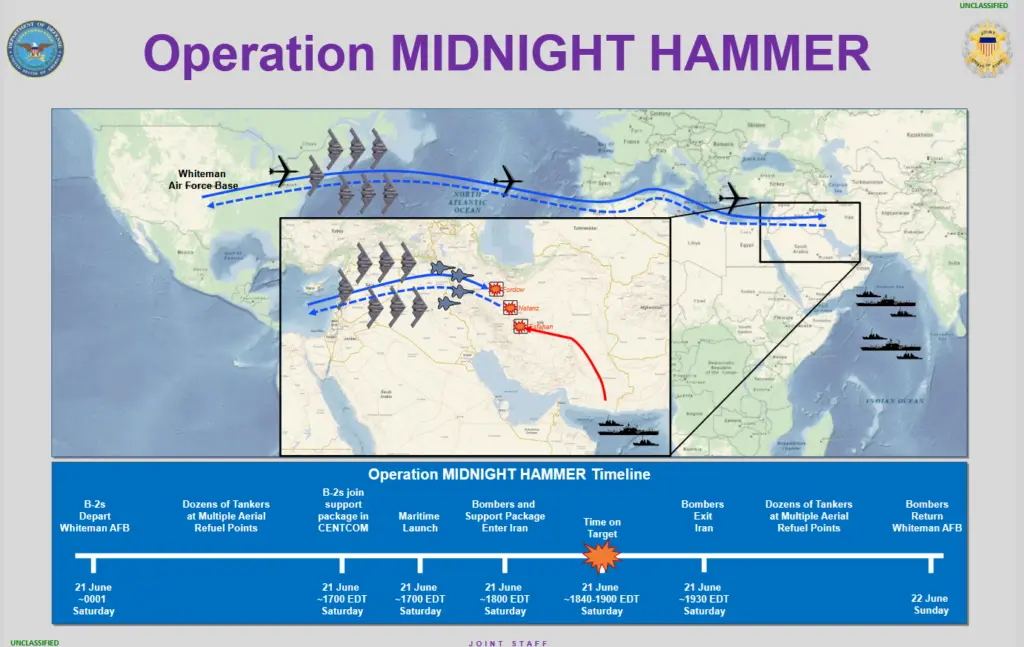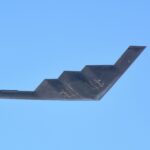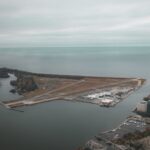Operation Midnight Hammer, carried out from late Friday into early Sunday, hit the Fordow, Natanz, and Isfahan nuclear complexes. Defense officials confirm seven B-2 Spirit bombers dropped fourteen 30,000-pound GBU-57 bunker-buster bombs, while a guided-missile submarine launched Tomahawk cruise missiles at surface facilities. More than 125 U.S. aircraft supported the raid. Senior leaders say the goal was to disable centrifuge halls buried hundreds of feet below ground and curb threats to American and allied forces in the Gulf.
The National Command Authority authorized the strike package after weeks of intelligence pointing to accelerated uranium enrichment. According to industry sources, planners received presidential approval just after 1700 EST on June 20. Within minutes, aircrews at Whiteman Air Force Base began mission sequencing, fuel loads, and final data card checks. Defense officials confirm that no civilian agencies outside the Pentagon learned of the timing before launch. Tight compartmentalization aimed to block early warning to Tehran and to reduce diplomatic blow-back.

The force mix, distilled from the air tasking order, contained:
- 7 B-2 Spirit bombers carrying MOPs for underground targets.
- 24 F-35A and 18 F-22A fighters acting as forward sweep and air-defense suppression.
- 12 EA-18G Growlers delivering stand-off electronic attack.
- More than 30 KC-135 and KC-46 tankers spread along three refueling tracks.
- 1 Ohio-class guided-missile submarine armed with at least 24 Tomahawks.
- Multiple E-3 and E-7 command-and-control aircraft orchestrating time-over-target spacing.
Deception and Electronic Warfare in USA Strikes on Iran Nuclear Sites
Two additional B-2s flew west toward Guam, creating social-media chatter that masked the real axis of attack. Tanker orbits shifted every six hours so commercial air-traffic services would log routine movements rather than a mass build-up. According to industry sources, the Navy submarine sailed a noisy course in the Arabian Sea, inviting satellite tracking, then cut engines and drifted to its launch box 200 kilometers off the coast.
At 0007 EST on June 21, the primary bomber cell departed Missouri under emission control. Eighteen hours later, over the eastern Mediterranean, they linked with fighters, Growlers, and tankers in a stacked racetrack 40 nautical miles long. Aircrews ran an encrypted data burst to confirm weapons status, then returned to radio silence. Support fighters accelerated ahead to sweep Iran’s western radar arc at 60,000 feet. No Iranian search radar lit up. Defense officials confirm that the entire penetrator wave maintained sub-one-meter radar cross-section until weapons release.
Precision Targeting of Iran’s Fordow and Natanz Uranium Enrichment Sites
At 1744 EST, the submarine fired the first salvo of twenty-four Tomahawk Block IV missiles. GPS updates in flight shifted aim points onto power substations and air-defense nodes surrounding Isfahan. Planners timed impact for 1841 EST, six minutes before the bomb run, to blind the local command network. Satellite telemetries recorded ninety-three percent hit probability. Navy leaders call the event the largest combat Tomahawk use since 2003.
While cruise missiles arced inland, Growlers jammed S-300 fire-control radars at Fordow and Natanz. F-35s released ADM-160B decoys that mimicked a much larger strike front, a tactic previously central to Operation Midnight Hammer in disorienting enemy air defenses.. Our analysis shows Iranian crews held launch authority on stand-by but never received stable tracks. F-22s, flying high cover, detected no fighter scramble from bases near Shiraz or Tabriz. According to a Joint Staff briefer, the integrated air-defense network stayed “silent, saturated, and confused.”
At 1847 EST, the lead B-2 rolled into a 25-degree dive and dropped the first pair of MOPs. The 31-second glide placed the weapons within six meters of the central ventilation shaft at Fordow. Six more drops followed, alternating between Fordow and Natanz. Penetration telemetry showed each bomb reached design depth before detonation. Engineers designed the MOP to punch through 200 feet of reinforced concrete; post-strike imagery suggests some penetrations exceeded that benchmark. This marked the weapon’s first operational use.
Assessment of Battle Damage and Limited Radiological Impact
Initial battle-damage assessment relied on overhead infrared and synthetic-aperture radar. Pictures released Monday show collapsed tunnel entrances, caved-in centrifuge halls, and scorched access roads. Analysts note that the strike avoided above-ground containment buildings, limiting radioactive release. Defense officials confirm no U.S. aircraft came under fire and none required inflight re-route for threats. All assets left Iranian airspace by 1915 EST.
Tehran’s first public statement, issued three hours later, acknowledged “technical damage” yet denied casualties. Iranian outlets circulated images of cracked concrete at Natanz but showed no interior views. By Sunday morning, state media reported partial power restoration at Isfahan, though independent sensors tracked a 40-percent drop in electrical load across the complex. According to industry sources, emergency crews pumped water into underground chambers to cool spinning centrifuges left running when power cut.
Regional Military Reactions Following USA Strikes Iran Nuclear Sites
U.S. Central Command raised base alert levels in Kuwait, Qatar, and Bahrain. Israel’s air-defense network entered a heightened readiness state but detected only limited missile fire from western Iran. Gulf Cooperation Council navies doubled patrol density in the Strait of Hormuz to guard commercial routes. Defense officials confirm no coalition vessel reported hostile action in the first twenty-four hours after the strike.
Sustaining the raid demanded an aerial-refueling effort on par with a large-scale exercise. Tankers off-loaded more than 2.8 million pounds of fuel. Air Mobility Command positioned spare aircraft at Diego Garcia and Incirlik to cover potential breakdowns. Flight-line maintainers at Whiteman turned returning B-2s for inspection within twelve hours, a tempo unseen since the 2003 Iraq campaign. Planners treated the quick turn as insurance against a follow-on tasking order.
Lessons Learned from Operation Midnight Hammer’s Multi-Domain Strike
Our analysis shows the operation underscored three points. First, stealth aircraft paired with electronic-attack assets can still penetrate modern integrated defenses when timing and deception align. Second, conventional bunker-busters remain viable against deep hardened targets if precise delivery is possible. Third, distributed refueling capacity and maritime launch platforms give commanders multiple axes and shorten response cycles. Each lesson feeds into procurement choices now under congressional review.
Looking ahead, intelligence teams will track restoration activity at all three sites. Commercial satellites pass over Fordow every six hours, and both NASA’s Fire Information for Resource Management System and the European Sentinel-2 constellation offer thermal data. Defense officials confirm a full structural survey may take weeks, because damage below 100 feet requires ground-penetrating radar and bore-hole imaging. No additional U.S. strikes are planned, but watch centers remain at heightened alert in case Iran attempts ballistic retaliation.
Operation Midnight Hammer closed without loss of life on the U.S. side and with minimal collateral damage reported so far. It demonstrated a fast, tightly threaded application of airpower across continents and domains. For planners, the raid validates investments in low-observable platforms, precision penetrators, and flexible logistics. For engineers studying hardened facility design, it offers new data on blast effects at depth. For policymakers, it raises questions about the future threshold for preventive action against nuclear programs. Those debates will unfold long after the last B-2 lands, but the technical record of the mission now enters the textbooks of modern strike warfare.
REFERENCE SOURCES
- https://www.thedailybeast.com/defense-secretary-pete-hegseth-declares-irans-nuclear-ambitions-obliterated-in-secret-midnight-attack/
- https://www.pbs.org/newshour/world/how-u-s-stealth-bombers-struck-irans-nuclear-sites-without-detection
- https://theaviationist.com/2025/06/22/operation-midnight-hammer/
- https://www.cbsnews.com/news/pentagon-briefing-us-strikes-iran-nuclear-sites/
- https://www.abcnews.go.com/US/bunker-busters-2-stealth-bombers-struck-heart-irans/story?id=123090581
- https://www.aljazeera.com/video/newsfeed/2025/6/22/us-strikes-iran-in-operation-midnight
- https://breakingdefense.com/2025/06/operation-midnight-hammer-how-the-us-conducted-surprise-strikes-on-iran/
- https://www.twz.com/air/b-2-strikes-on-iran-what-we-know-about-operation-midnight-hammer
- https://www.airandspaceforces.com/the-weapons-of-operation-midnight-hammer-mops-tomahawks-and-more/
- https://www.hindustantimes.com/world-news/us-news/operation-midnight-hammer-b-2-stealth-bombers-to-tomahawk-missiles-full-list-of-weapons-used-by-the-us-to-target-iran-101750601619089.html


